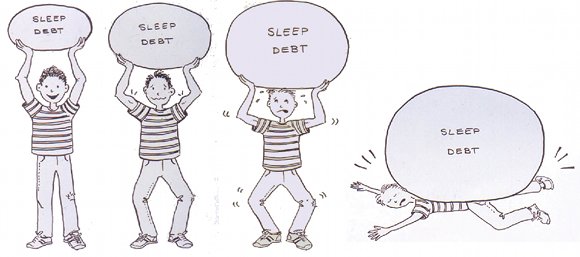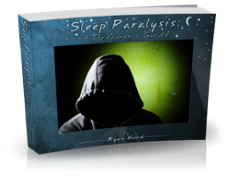
| Connect & Subscribe |
Get More Sleep! Avoiding The Perils Of Sleep Debt
An Outreach Project by Nick Wenner | Return To Outreach Projects 2010
My name is Nick Wenner, and I grew up in Klamath Falls and graduated from Klamath Union High School in 2007. With homework, socializing, jazz band at 7 AM every morning, and cross-country practice, I usually got about six hours of sleep each night during the week when I went to KUHS. As a result, I was usually tired during the day, especially in the afternoons.
This only got worse in my first two years of college at Stanford University. I am now in my third year at Stanford and I am taking a class entitled "Sleep and Dreams." In this class, I have been learning the science of sleep from William C. Dement, one of the primary researchers and founders of the discipline. I have been surprised by how little I knew about the 1/3 of my life I have spent in bed. I have written this Letter the Editor to share the most important thing I've learned in class: The concept of sleep debt.
What is sleep debt?
"Sleep debt" refers to the observation that sleep deprivation is an additive process: Every hour of sleep a person gets less than his or her nightly requirement appears to be carefully registered by the brain as a debt, and this debt appears to be added nearly hour for hour over time and must be "paid off" at a later date in order to regain full function of those factors affected by sleep loss. This means a night of sleep lost several weeks ago may very well continue affecting your mood, awareness, and general health until that sleep is paid off!
What are the effects of sleep debt?
Carrying a large sleep debt can seriously affect mood, physical health, and general wellbeing. One of the most obvious effects of carrying a large sleep debt is the tendency to feel drowsy throughout the day and a strong tendency to fall asleep during sedentary activities such as working at a computer or--often to fatal consequences--driving.
 We can think of sleep debt like a growing weight over us that we have to carry around throughout the day. Unless paid back, the debt gets bigger and bigger while we're awake until...SQUASH!!! We're asleep!
We can think of sleep debt like a growing weight over us that we have to carry around throughout the day. Unless paid back, the debt gets bigger and bigger while we're awake until...SQUASH!!! We're asleep!
How do we know sleep debt exists?
Researchers learned that human beings could unknowingly carry a large sleep debt in a study that aimed to study the effect of light sources on sleep. In part of the experiment, carried out by Dr. Thomas Wehr and his colleagues at the National Institutes of Health, subjects were left in bed in the dark for 14 hours every night for 35 days.
At the beginning of the study, total daily sleep times for subjects jumped to amounts above 12 hours on the first night and then gradually declined. By the fourth week, the sleep time for the group had leveled off at a nightly average of a little over 8 hours. The interpretation is that the subjects went into the study unknowingly carrying a substantial sleep debt. Once the subjects were able to pay off this sleep debt in the first weeks of the study, they reached a steady state where they slept the same amount each night and could not sleep longer than that amount. The subjects reached a steady state value of about 8 hours of sleep per night, which means they lay in bed in the dark with nothing to do for about 5 hours each night!
This leads to an important insight: Contrary to popular belief, you cannot physically sleep too much! Once you have paid off your sleep debt, you will not be able to sleep for more time than you physically need and you will no longer feel sleepy during the day.
How much sleep debt do I have?
A simple way to gauge the amount of sleep debt you are carrying around is to notice how fast you fall asleep at night after laying down. If you fall asleep within 5 minutes of lying down, you probably have severe sleep debt. A person with zero sleep debt may lie in bed 15-20 minutes with a clear mind before actually falling asleep.
Unlike most people today, a person with zero sleep debt will not feel tired throughout the day and will feel little need to sleep until night arrives.
How do I get rid of my sleep debt?
A large sleep debt does not go away spontaneously and it can only be reduced by getting extra sleep. The amount of sleep people need per night varies from person to person, but it's useful to say most teenage and college-age people need something on the order of 8 hours and 30 minutes of sleep per night. Needing less than 7 or more than 10 hours would be rare
The best way to eliminate sleep debt is to consistently sleep more than your daily sleep need every night. Note that you probably will not be able to sleep through an entire weekend to pay of your sleep debt because your biological clock tends to wake you up eventually during the daytime even when you have a large sleep debt.
The maximum amount of sleep debt a person can carry around before collapsing is somewhere between 30-50 hours. I've kept a log of my sleep each night at school this year. Assuming I need the average amount of 8 hours and 30 minutes of sleep each night, I've succeeded in eliminating about 18 hours of sleep debt. I can say I feel much more rested during the day now and that I have enjoyed the long hours I spend in bed.
Who wouldn't like paying off debts while you sleep?
I have made some generalizations in this article. If you would like to learn more about sleep debt and sleep science in general, I recommend I recommend reading "The Promise of Sleep: A Pioneer in Sleep Medicine Explores the Vital Connection Between Health, Happiness, and a Good Night's Sleep," by Dr. William C. Dement, my professor in Sleep and Dreams. Dr. Dement has studied diverse aspects of sleep and dream science for more than 50 years, discovering and naming the five stages of sleep scientists recognize today.
About This Site
Welcome! This site is continuously being created by students of Dr. William C. Dement's Sleep And Dreams course at Stanford University.
We made this site as a call to action for people all over the world to live healthier, happier, safer, and more productive lives by learning about their own sleep. We have faith that reading the information provided on this site will motivate you to be smart about your sleep deprivation and strategic about your alertness in order to live life to your fullest, most energetic potential.
In fact, we challenge you to do so! What do you say, are you up for the challenge?
Interviews With Sleep Specialists: Insights Into the Worlds of Sleep Medicine & Sleep Business
America's Most Dangerous Disorder: What Is Sleep Apnea Doing To Your Sleep?
Sleep Debt: How Much More Will You Achieve When You Reduce Yours?
The Stages Of Sleep: The Journey Through The Night
Delayed Sleep Phase: You Want To Sleep But You're Not Tired Yet
Paralyzed at Night: Is Sleep Paralysis Normal?
Sleep In Words: Smart, Strange, and Funny Quotes About Sleep
Sleep Disorders In Children: What's Keeping Your Child From A Full Night's Rest?
Attacks of Pavor Nocturnus (a.k.a. Sleep Terrors, Night Terrors, or Incubus Attacks)
The Stanford Sleep Book
Dr. Dement's pioneering textbook has been the core text for Sleep and Dreams since 1980, but it has just recently been made available to the wider public for the first time.
In it you'll find a more detailed account of the most important things you need to know about sleep, alertness, dreams, and sleep disorders. Studies, statistics, plus plenty of Dr. Dement's classic anecdotes painting the history of sleep medicine.
Preface | Intro | Contents | Get A Copy
More Sleep Resources
The Zeo
A revolution in personal sleep tracking, the Zeo is a wireless headband that transmits your brainwaves in realtime to a dock (pictured here) or your smartphone. The result? You can wake up and see exactly what stages of sleep you were in during the night! Unprecedented personalized sleep knowledge.
Sleep Paralysis: A Dreamer's Guide
Ever woken up paralyzed? A surprising number of us have, believe it or not. But few know the actual causes of this phenomenon, and fewer still how to exert control over it. Dream researcher and sleep paralysis expert Ryan Hurd shares breakthrough insights into how to do just that.
Important Disclaimer
Please Note:
The information found on this page and throughout this site is intended for general information purposes only. While it may prove useful and empowering, it is NOT intended as a substitute for the expertise and judgments of healthcare practitioners.
For more info, see our
Terms of Use.









